How to quickly and tasty pickle trout caviar at home is a question that interests many housewives. Fish caviar is an excellent delicacy and a very healthy product. And you will be able to do it quickly and tasty if you follow our step-by-step recipes with photos. Trout meat, like its caviar, is very valuable because this fish lives in clean water, but the most useful trout is the one caught not at a fish farm, but in the river. Trout caviar is small, bright orange. Salt it according to one of our 6 recipes and enjoy the unsurpassed taste!
Methods for cleaning caviar
If you rip open the belly of a female salmon or sturgeon fish, you will see that the caviar there is in a strong film - a shell, which needs to be removed, and the eggs separated from each other in order to prepare for salting. Several ways have been invented to separate the eggs of trout and other valuable fish from eggs.
More often than other devices, they use clean, large gauze, folded in several layers like a bag or pocket, where the caviar is placed in yaks, and then twisted and immersed in a basin of warm water and slowly rotated. The film remains on the gauze over time, and the eggs slowly separate from it.Using this method, you need to know that the water for washing eggs should be warmer than room temperature, since cold water makes the eggs hard, which unpleasantly affects the taste of the final product.
The next way to separate caviar is to use very hot water, which is poured over it for literally 10-20 seconds. During this short time, the film has time to brew and begins to easily separate from the eggs. After which the water is drained, but the remaining film will still have to be thoroughly cleaned.
Some people prefer to remove the eggs from the eggs with their hands, breaking the eggs into several large pieces, and then slowly and carefully remove each egg individually. This method is labor-intensive and requires patience and careful attention, otherwise the eggs will burst.
Another method is to rub the caviar through a screen (mesh or bag with small cells) over a basin.
Washing with a whisk - the egg is torn in several places and placed in water, and then a culinary whisk is immersed in the same place and the caviar is stirred with it. The film is gradually wound around the whisk, after which the caviar is poured onto a sieve and sorted from the remaining film by hand.
When good caviar is completely wiped or separated from eggs and damaged eggs, it is washed in warm salted water.
A quick way to salt caviar
A quick way to salt trout caviar or other red fish yourself is an easy way to pamper yourself by arranging an excellent feast with a delicious homemade delicacy - red caviar on sandwiches. And how delicious it is with pancakes topped with melted butter! Be sure to try it!
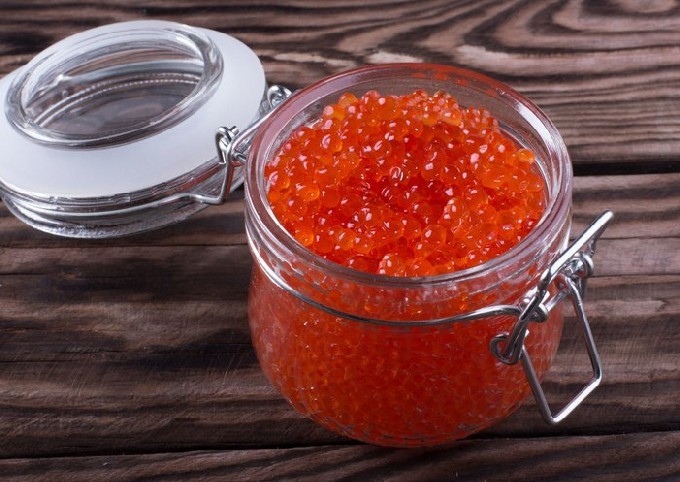
- Red caviar 250 (grams)
- Salt 10 (grams)
- Granulated sugar 5 (grams)
-
How to quickly and tasty pickle trout caviar at home? Remove the red trout caviar from the eggs - this process is labor-intensive and will take up the most of your time.
-
Rinse the caviar through a sieve with lukewarm salted water.
-
With salt and sugar, which should sprinkle the caviar thickly, stir it carefully so that the eggs are not damaged. Let the caviar stand for 10 minutes.
-
Place the caviar in cheesecloth (pull the cheesecloth over the pan) and let all the liquid that has formed drain off.
-
Place the caviar into a clean, dry, small glass jar, close it with a lid and place it in the refrigerator. Eat this tender lightly salted homemade delicacy every other day.
Bon appetit!
How to pickle trout caviar in brine
You can often find such an old method of preparing red fish caviar at home, especially widespread in the Volga region and the Far East, as salting it in brine, that is, in a strong solution of concentrated salt.
Ingredients:
- Rock salt – 100 gr.
- Sea salt – 100 gr.
- Water – 1 l.
- Trout caviar.
Cooking process:
1. Boil water, add both types of salt, or simple rock salt if you don’t have sea salt, in an amount of 200 grams. Boil the brine for 3-5 minutes and cool to 40-45 degrees.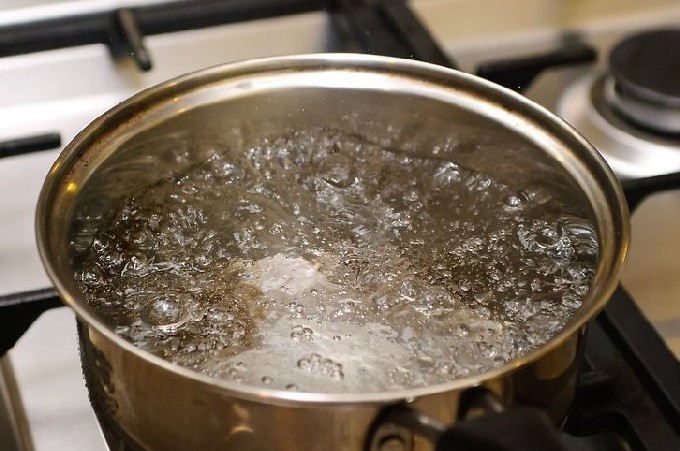
2. Immerse the caviar in the brine for 10-15 minutes if you plan to store it in the refrigerator longer, and if you keep it in the brine for only 7-9 minutes, then you will get lightly salted caviar, which will be stored for no more than three to five days.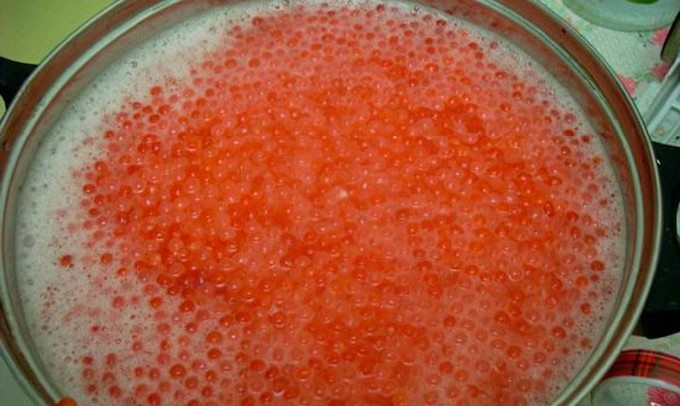
3. Strain the caviar onto cheesecloth stretched over a saucepan to allow the water and salt to drain. Then let the eggs remain in the air for another 10 minutes and become airy.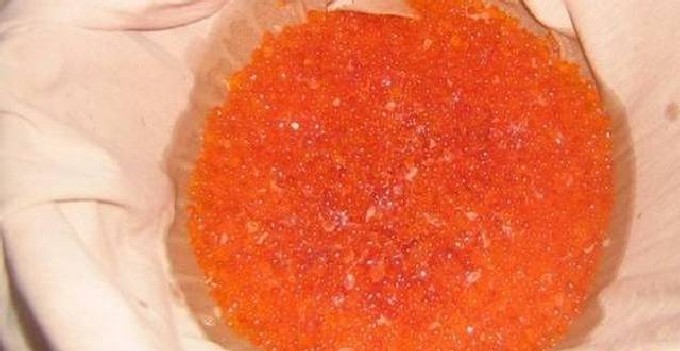
4. Boil the jars, as well as the lids, and then dry them and place the caviar in them.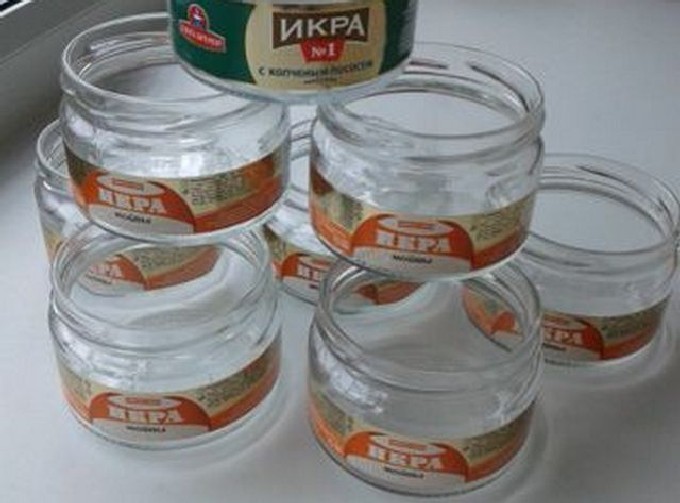
5.Tightly lidded jars of caviar are stored cold or in the refrigerator. The caviar will be ready for consumption in 12-24 hours.
Bon appetit!
Trout caviar in sugar brine
In a sugar brine, you will get sweeter homemade trout caviar than in the usual classic one, where exactly twice as much salt is added as sugar. The good thing about this product is that you can make your own delicious fish delicacy without worrying about its quality, which is not always the case with store-bought products.
Ingredients:
- Salt – 80 gr.
- Sugar – 50 gr.
- Water – 1 l.
- Caviar.
Cooking process:
1. Clean the trout caviar from the films, then rinse well and place in cheesecloth over a saucepan so that all the liquid is completely drained from it.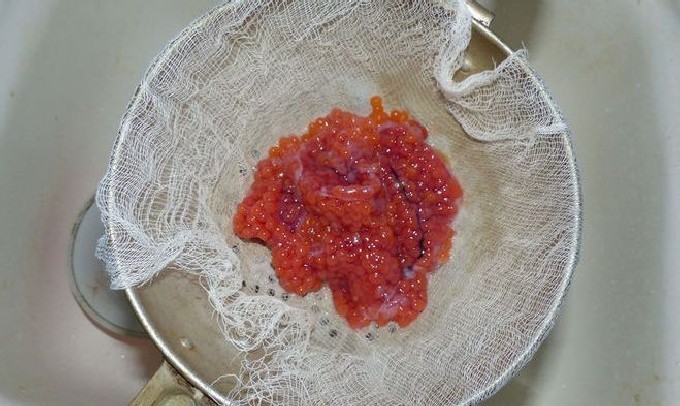
2. The brine (salt and sugar) needs to be boiled for 3 minutes if you want the caviar to be stored for some time in the refrigerator. If you plan to eat all the caviar the next day, then salt and sugar can simply be completely dissolved in warm boiled water.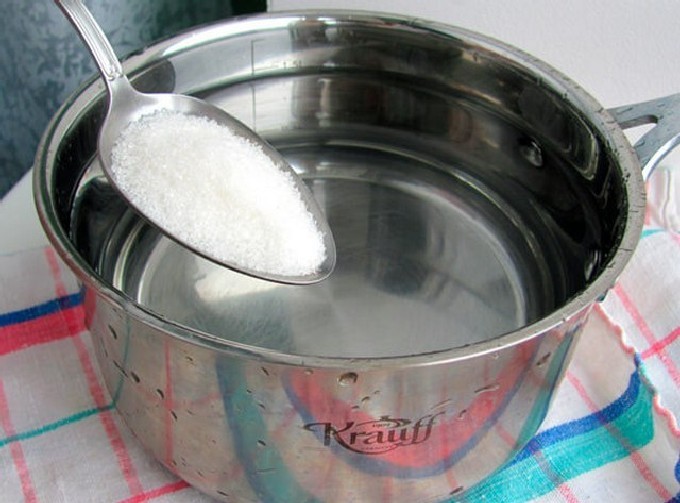
3. Place the caviar into a deep container and fill it with brine, the temperature of which should be about 45 degrees. Soak the caviar in brine for 15 minutes.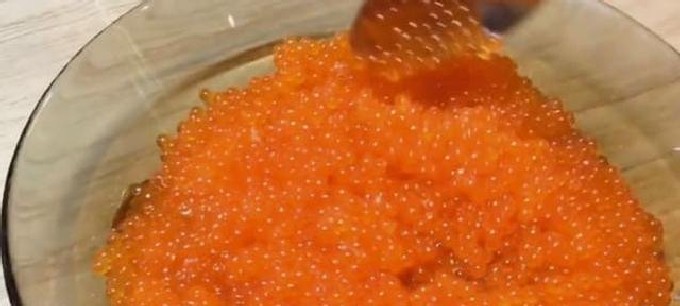
4. Stretch the gauze over the pan; its ends can be tied to the handles so that the gauze does not sag. Place the caviar in a thin layer on cheesecloth after the specified time, let the brine drain, and then let it air for another 15 minutes.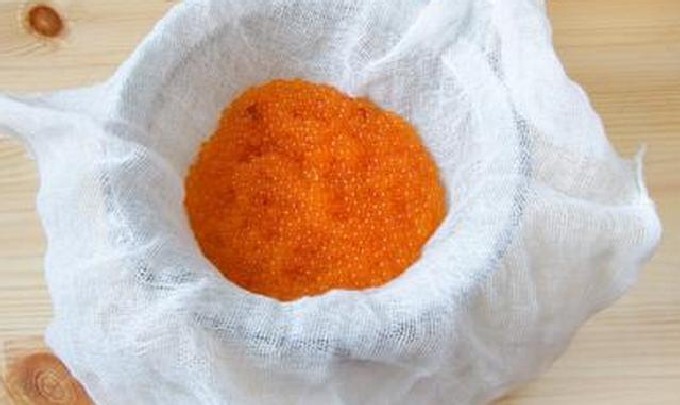
5. Place caviar in clean and dry jars and place it in the refrigerator.
6. After 12-24 hours, the caviar will be ready.
Bon appetit!
Spicy pickled trout caviar
If you like spicy salted fish, then be sure to prepare spicy salted trout caviar at home.Such a product will not have a very pronounced fishy smell, but will have the aroma of spices and herbs. In addition to the spices and herbs indicated in the recipe, you can experiment and add other spices and herbs, for example, your favorite ones, to the brine.
Ingredients:
- Trout caviar – 200 gr.
- Water – 0.5 l.
- Salt – 40 gr.
- Sugar – 15 gr.
- Bay leaf – 1 pc.
- White peppercorns – 3-4 pcs.
- Allspice peas – 5 pcs.
- Carnation in buds – 2-3 pcs.
- Ginger - on the tip of the knife.
Cooking process:
1. Add spices, salt and sugar to the water, then bring it to a boil and boil for no more than three minutes. Cover the pan with a lid to allow the brine to cool. If you have more caviar than indicated in the recipe, then you need to take more water and spices to prepare more brine.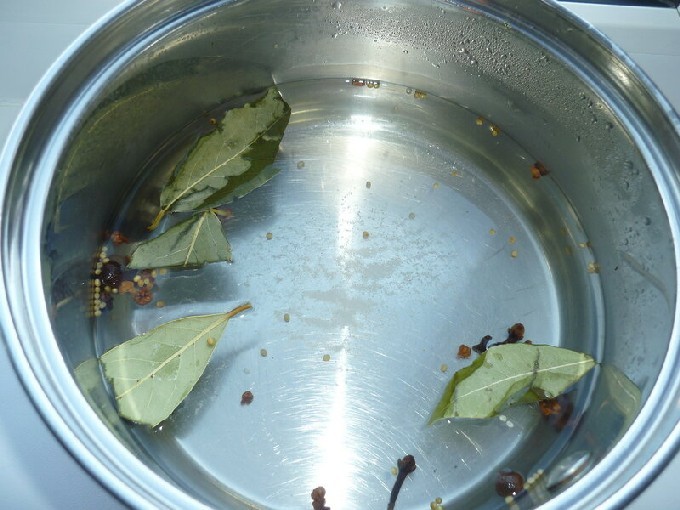
2. When the brine has cooled to 50-45 degrees, it needs to be filtered. Place the caviar in a clean brine and keep it there for 15-20 minutes.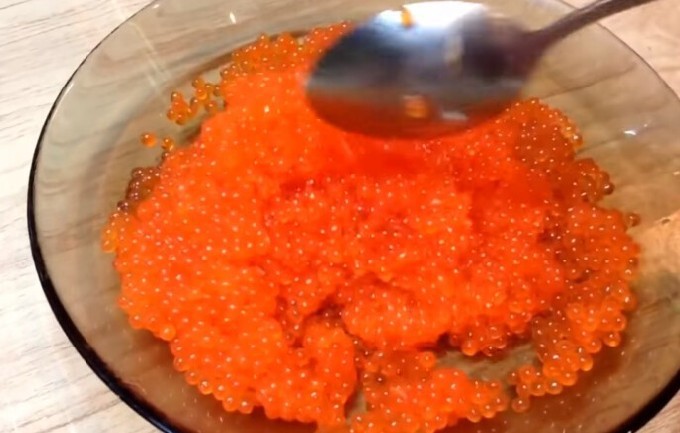
3. Strain the caviar from the brine using cheesecloth or use a fine sieve to catch it. Let the water drain completely and dry the eggs for 10-15 minutes.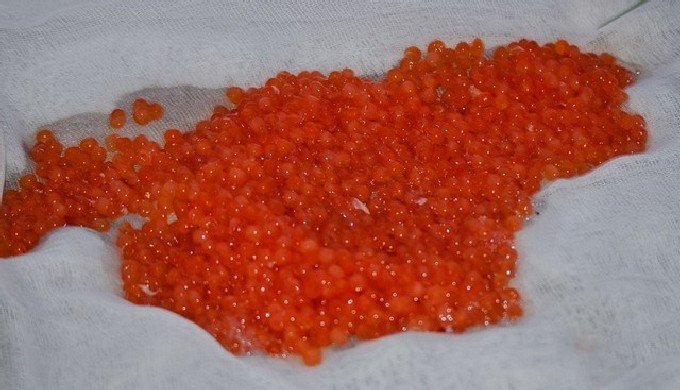
4. Store the caviar in a glass jar for at least a day until it is completely salted.
5. Spicy-salted trout caviar is equally good as an addition to a fish salad, or as a filling for canapés, pastry baskets, or on sandwiches.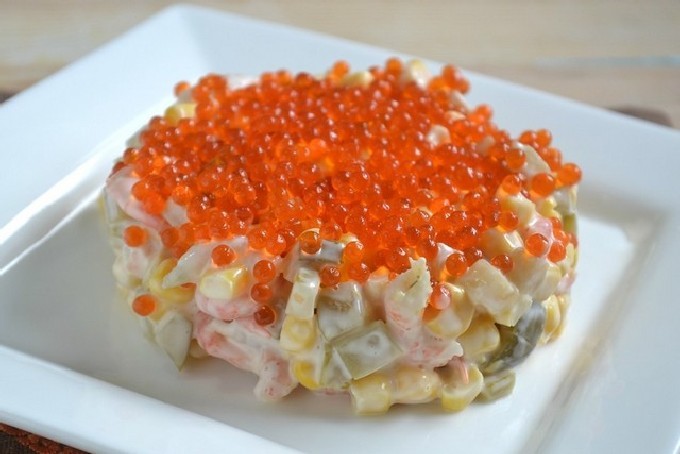
Bon appetit!
Trout caviar with lemon
Trout caviar is perfectly salted with lemon - thanks to the added lemon zest, this delicacy acquires a subtle and very delicate citrus aroma. In addition, it is best to add sea salt, not ordinary salt, to the brine required for pickling. If this is not available, then use standard coarse salt.
Ingredients:
- Caviar – 250 gr.
- Lemon – 0.5 pcs.
- Sea salt – 2 tbsp. l. with a slide.
- Sugar – 1 l.
- Water – 0.6 l.
Cooking process:
1. Completely free fresh or thawed trout caviar from films in a manner that is convenient for you.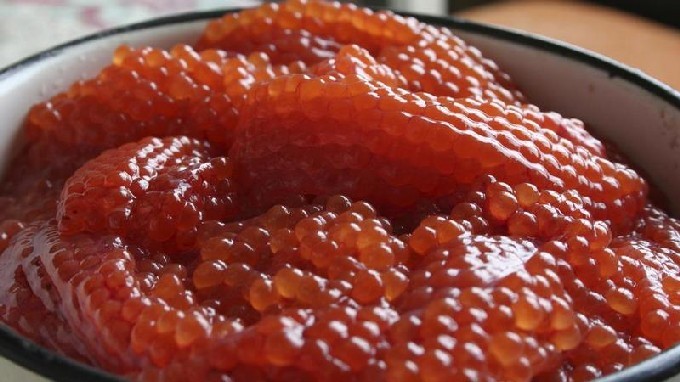
2. Using a grater, remove the zest from one lemon (you can cut the skin very thinly with a knife), and squeeze the juice into another bowl and strain.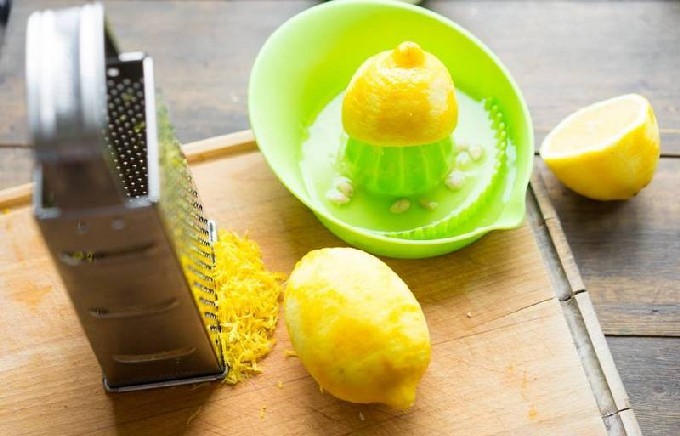
3. For salting, you need to prepare a brine. To make it, bring the water to a boil, add lemon zest (or lemon peel) and boil for 3-5 minutes, then add salt and boil for another 3 minutes. Let the brine cool to about 50 degrees, then strain it through a sieve.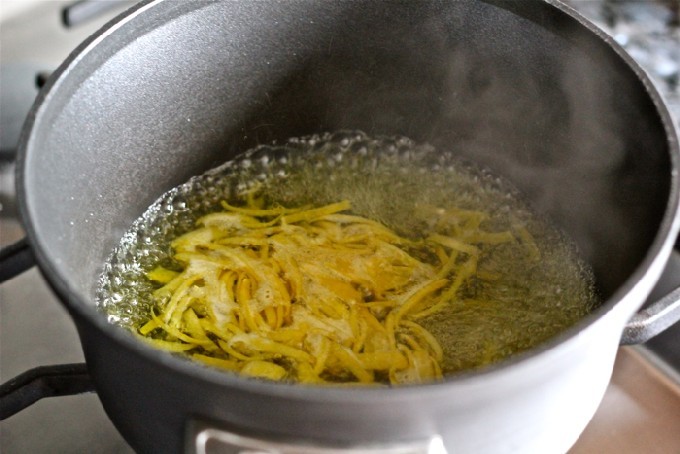
4. Place the caviar in a warm brine and add the juice from a whole lemon or half a lemon if you don’t like it sour. Let the caviar lie in the brine for 15-20 minutes.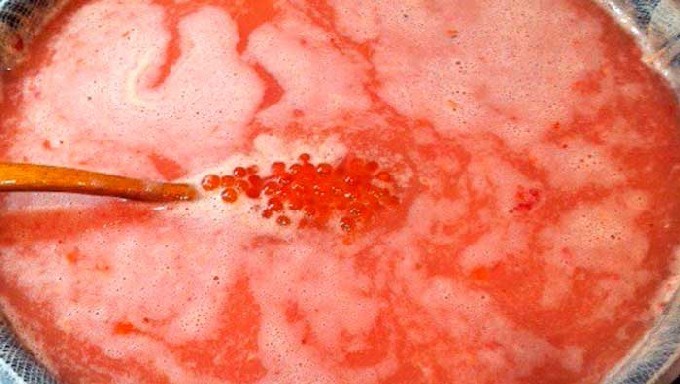
5. Place the caviar on a sieve and leave until the water has completely drained. Then let the caviar sit for another 15 minutes to dry slightly.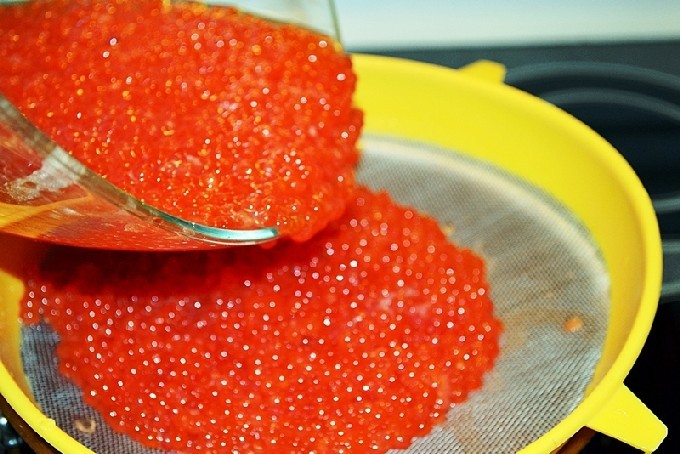
6. Place caviar in clean small glass jars for salting under a lid in the refrigerator. Eat homemade trout caviar within 1-2 days.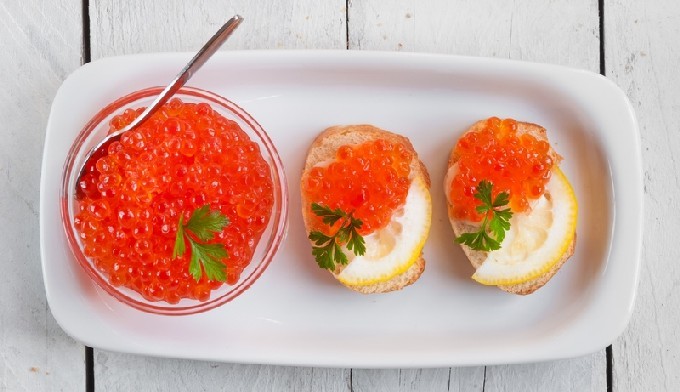
Bon appetit!
Dry salting of trout caviar
You can dry-salt trout caviar if you are lucky enough to catch in a river or buy whole fresh or frozen trout, inside of which there is a surprise - eggs with caviar. Of course, you can fry fish roe, but if you have the time and desire, then the best thing you can do with it is to prepare a chic homemade delicacy.
Ingredients:
- Red fish with caviar – 1 pc.
- Coarse salt per 100 g of caviar – 1 tsp.
Cooking process:
1. Wash the fish, then carefully open its belly so as not to damage the caviar storage area - the ovaries. If your trout is frozen, you need to defrost it first.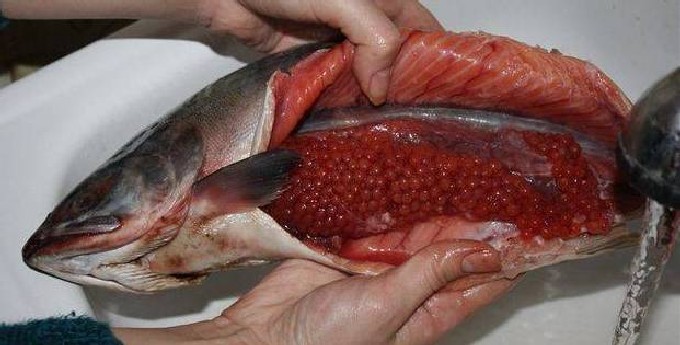
2. Wash the caviar in the eggs quickly and let it dry a little.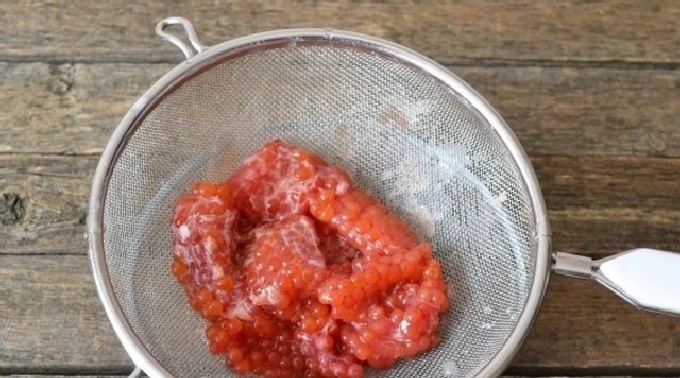
3.If you have little caviar, then it will not be difficult to remove it from the film simply by hand. However, if you do this carefully so as not to damage the eggs, you will have to spend about an hour to “release” each individual egg. If there is still some caviar left on the film, it can be washed off with water.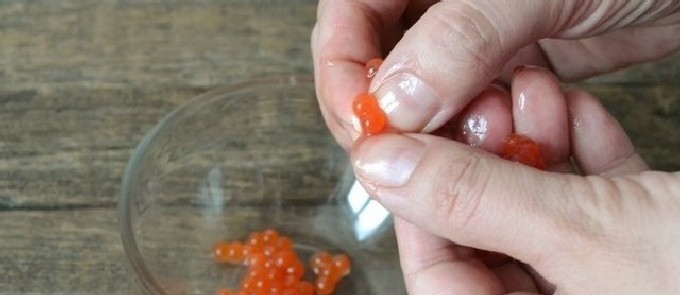
4. Place the caviar in a bowl and add salt; the amount can be increased or decreased at your discretion.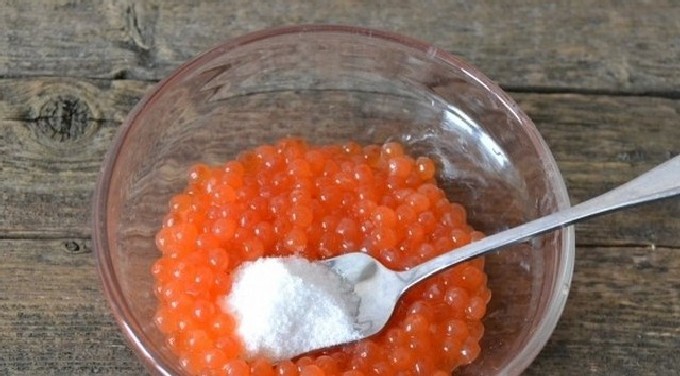
5. Gently stir the salt with the caviar and refrigerate it to infuse and salt in a glass jar with a lid. If you have salted a small amount of caviar that is not intended for long-term storage, you can simply leave it in a glass bowl under cling film or covered overnight.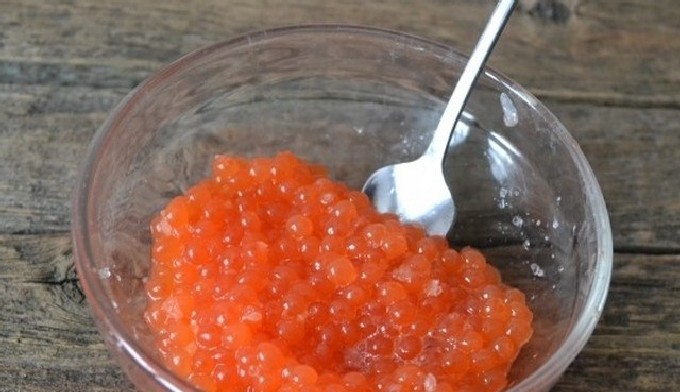
6. The next day, dry-salted caviar is ready for consumption.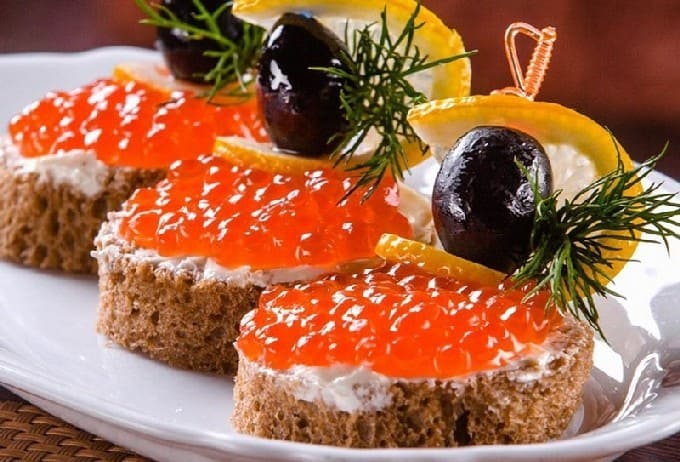
Bon appetit!
Helpful Tips and Tricks
To pickle delicious trout caviar, you need to buy fresh fish or catch it yourself. When choosing a female fish with caviar, you need to focus on its appearance: females have a lighter color and a rounded head, while males have a pointed head.
The caviar from the trout carcass must be removed very carefully, opening its belly with a very sharp, thin knife along the edge, so as not to go deep and damage the caviar.
The caviar is washed in salted water, not fresh water. Salt for pickling should be coarsely ground, not iodized or fluoridated.
After salting, trout caviar, like caviar of other types of fish, is recommended to be stored not just in clean, but preferably in sterilized jars.
Fresh fish eggs have a pleasant smell, they look clean, without stains or rot. Fresh caviar, after being removed from the fish, must be salted no later than six hours later, or a maximum of one day.And the caviar is removed from the fish no later than half an hour after catching, otherwise the eggs may lose their elasticity and burst right in the belly, which is harmful for the caviar.
You can also pickle caviar extracted from frozen fish, which is first kept in the refrigerator for about 4-6 hours, and then completely defrosted at room temperature. Defrosting too quickly is harmful to the caviar; it spoils and bursts. It will no longer be possible to pickle such caviar.
Do not skimp on salt: it is needed not only to give the product taste, but also to kill the larvae of helminths and other harmful microorganisms that can be contained in caviar and be very harmful to humans. Too salted caviar is poured with cooled boiled water or cool black tea for 10 minutes before serving, and then the water is allowed to drain.
If you do not have time to finish homemade caviar (its shelf life does not exceed five days to a week), then place it in small portions in the freezer, and then defrost as needed.

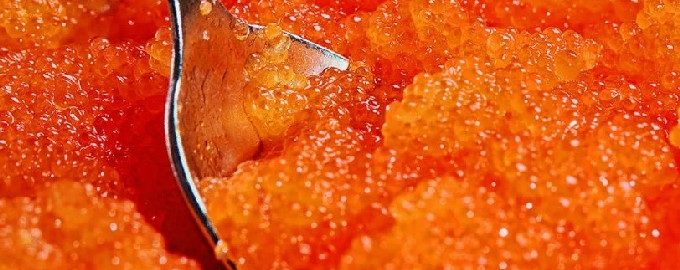
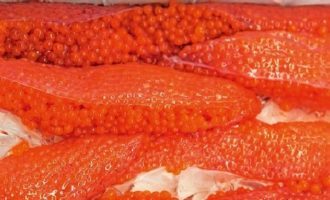
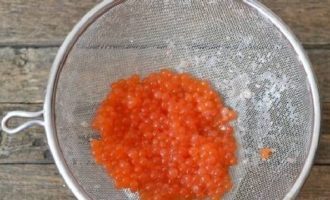
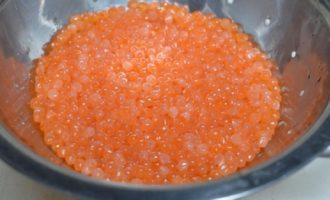
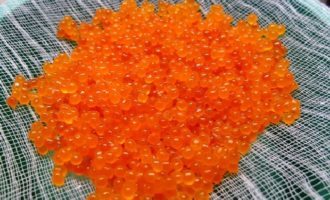
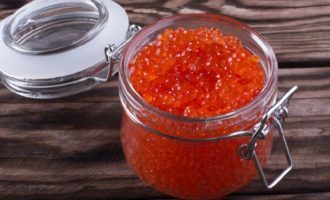


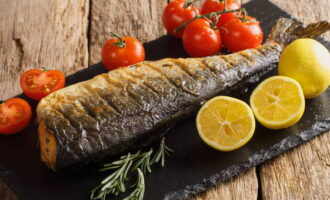





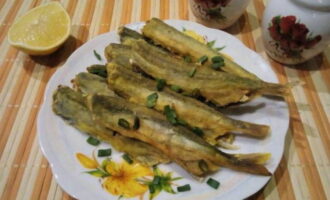



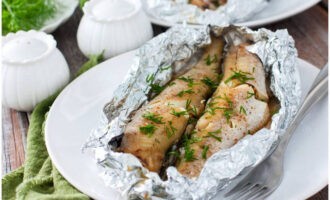
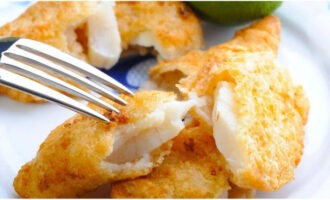










Why do we need sugar? I can’t understand, because... all the taste of fish caviar disappears. Nowadays they put sugar everywhere when salting fish, even in herring. Eating is not possible. The taste of sugar is everywhere. Try adding salt without sugar and you will feel the difference.
Svetlana, if you don’t like sugar, don’t add it, for example, when I cook caviar, I use only salt; if I cook fish, I use salt and sugar in a ratio of 2 to 1, but I also know many people who like to make salt and sugar 1 to 1 and I even came across 4 to 5 in favor of sugar and all these people claim that for their taste this is the most successful proportion! All this is very individual and, having tried different options, you will very quickly find exactly the one that will suit your preference. Happy upcoming holidays to you!!
The caviar turned out quickly and tasty, thank you!
I was just lucky to buy trout with caviar. And you were lucky to cut the belly carefully. Regarding cleaning, you are absolutely right! I spent more than an hour until I cleared the film 🤦♀️.One good thing is that it was worth it! Tomorrow we will enjoy the delicious food. Thanks for the advice! This is the first time I've been so confused.
Thanks for the comment! Glad you liked the recipe!
I salt with added sugar - I like it, the taste is more emphasized. It's all a matter of taste. Thanks for the recipe.
I'm salting caviar for the first time. I used the dry method. Regarding cleansing caviar from films, I found a fairly simple option. I soaked whole bags of caviar in warm salted water and, without removing it from the water with a tablespoon, separated the eggs with small movements. The time was quick, the eggs were intact and the film itself came off easily and did not tear.